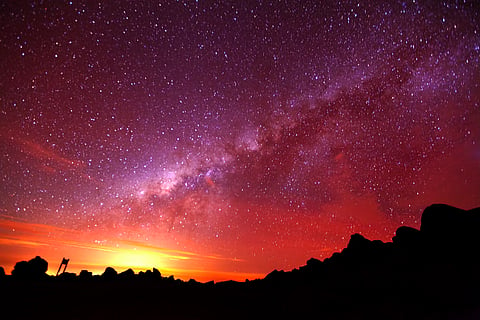

Celestial Events in May | Imagine standing on the edge of infinity, gazing into the vastness of the cosmos. Beyond the confines of our humble planet lies a realm so immense, so unfathomable, that even the brightest minds among us are explorers in a sea of endless discovery. This May, stand in awe of the universe that surrounds us, for it is a realm of wonder and majesty beyond our wildest dreams. As May unfurls its celestial canvas, prepare to be swept away on a journey beyond the confines of Earth.
For the majority of the night, Asteroid 4 Vesta will remain well above the horizon and be clearly visible in the constellation Libra. Regardless of your location on the planet, it will peak at midnight local time.
In New Delhi, it will begin to show up in the morning sky at 21 degrees above the eastern horizon at 20:21. It will peak at 57 degrees above the southern horizon at 00:32 and then fade into dawn at 22 degrees above the western horizon at 04:37.
Before it sets at midnight, the Moon will reach its first quarter phase, when it will be bright in the evening sky. It will be visible in New Delhi from 11:52, shortly after sunrise, to 01:28. It looks to be nearly 50 per cent lit at this point in its monthly cycle.
The Moon's phases alternate between new moon, first quarter, full moon, last quarter, and new moon as it revolves around the Earth every 29.5 days. It is the perfect time to see in the evening because it rises in the afternoon during the first quarter, appears high at sunset, and sets around midnight.
The globular cluster M5 (NGC 5904) in Serpens will be well positioned in the evening sky in the coming weeks. On May 11, it will reach its highest point around midnight local time, culminating four minutes earlier each subsequent night.
In New Delhi, it will be visible all night, appearing at 20:03 IST at 23 degrees above the eastern horizon as dusk fades, reaching its peak at 00:24 at 63 degrees above the southern horizon, and disappearing into dawn twilight around 04:29 at 25 degrees above the western horizon. Located at a declination of 2°04'N, M5 is visible across much of the world, from latitudes 72°N to 67°S. With a magnitude of 5.7, it is too faint for the naked eye except from the darkest sites but can be seen with binoculars or a small telescope.
The Moon and Saturn will make a close approach, passing within 2°28' of each other, with the Moon at 25 days old. From New Delhi, the pair will be visible in the dawn sky, rising at 02:24 IST, about three hours before sunrise, and reaching an altitude of 30 degrees above the eastern horizon before fading into the morning light around 04:48. The Moon will shine at magnitude minus 11.3, while Saturn will be at magnitude 0.9, both positioned in the constellation Pisces. Though too widely spaced for a telescope’s field of view, they will be easily visible to the naked eye or with binoculars.
The Moon and Jupiter will align in the same right ascension, with the Moon passing 5°12' north of Jupiter at just one day old. From New Delhi, the pair will become visible around 19:28 IST, positioned 13 degrees above the western horizon as twilight fades. They will gradually descend and set by 20:40, about 1 hour and 29 minutes after sunset. The Moon will shine at magnitude minus 9.0, while Jupiter will be at magnitude minus 1.9, both in the constellation Taurus. Though too widely spaced for a telescope or binoculars, they will be easily visible to the naked eye.
